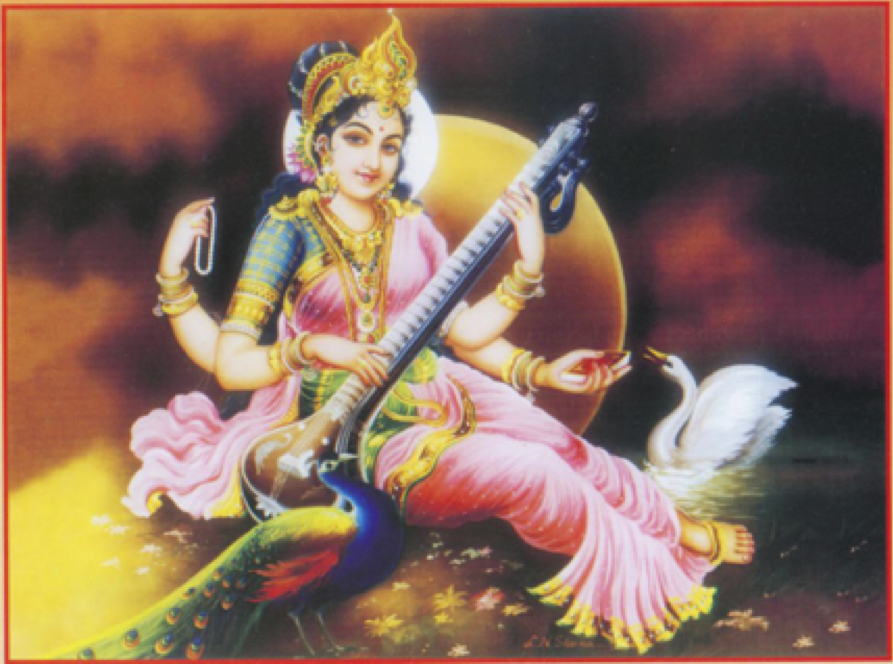
yaa kundendu tushhaar haara dhavalaa yaa shubhravastraavR^itaa .
yaa viiNaavarada.nDa ma.nDitakaraa yaa shvetapadmaasanaa .
yaa brahmaachyutasha.nkaraprabhrutibhirdevai sadaa va.nditaa .
saa maaM paatu sarasvatii bhagavatii niHsheshha jaaDyaa pahaa .
Fair as a jasmine flower, the moon or a flake of snow,
Dressed in white, her hands adorned by the graceful veena staff,
Adorned by Brahma, Vishnu, Shiva, and the other deities,
Protect me, Oh Goddess Saraswati, remover of ignorance inert.
Gods and goddesses as the manifestation of the One Bhagawan, Para-Brahman or Purushottam have been the primary divine powers in Vedic Traditions since the time immemorial. Goddess Saraswati is one of them whose earliest references are found in Vedas. She has been associated with the goddess of speech and sound, Vak; she manifests as the most sacred river, Saraswati, some portions of which have now been discovered, some segments dried, other with running water, underground. Just like other divine powers, she is polymorphous and, as a result, her nature is multifarious. Her purifying power is suggested in her association with medicine and healing, while her power of speech is associated with learning, art forms, and wisdom.
Goddess Saraswati’s origin is described differently in different scriptures, a kind of mystery. According to scriptures Brahma-Vaivarta-Purana and the Devi-Bhagavata-Purana, she is one of the five primary saktis (dynamic powers) of Bhagawan Krishna, the supreme personality of Godhead. Her specific creative function is to pervade reality with knowledge, learning, and insight.
In iconographic depiction, Saraswati appears with gleaming white body and garments, which express her purity-like white snow and transcendence. In her four hands she holds a book, a vina, a rosary, and a water pot. The book symbolizes sciences and learning; the vina, musical and performing arts; and the rosary and water pot represent spiritual sciences, religious rites, and the creative consciousness. The swan, which is a symbol of adhyatmic transcendence and perfection, is the vehicle for Saraswati. The divine personality and image of Saraswati, as indicated above, clearly depicts the underlying unity within the seemingly different aspects of the physical, natural, and divine worlds, as experienced by Vedic seers.
It is most instructive to see that in the modern world’s view, the physical sciences, arts, religion, and spiritual sciences have been suggested to be incompatible with each other and, hence, they must be compartmentalized within the rigid walls of separation, with little or no inter-connectivity. While the multidimensional, highly pregnant and loaded term Sanatan Dharma, Hindu Dharma, or Vedic Dharma must be recognized to contain in its folds all aspects of the existence, and beyond.
A new dimension emerges with Saraswati, which uplifts human existence beyond and above the physical and natural world. David Kingsley puts it so beautifully as: “Her realm is one of beauty, perfection, and grace; it is a realm created by artistic inspiration, philosophic insight, and accumulated knowledge, which have enabled human beings to so refine their natural world that they have been able to transcend its limitations. Saraswati, astride her swan, beckons human beings to continue cultural creation and civilized perfection.”
In many parts of India special puja for Saraswati is performed during early spring season. On this day, very beautiful deities of the goddess (when a murti or image is embodied by a god or goddess after appropriate invocation, that murti or image becomes that deity) is established in schools and colleges and special worship is performed. Also on this day books, musical instruments, and gurus are formally revered and worshipped. Interestingly enough, on this auspicious day a special procession of faculty and students takes place at Banaras Hindu University, India.
How to embody adhyatmic aspect of Mother Saraswati in our life?
Performing Saraswati Pooja remains incomplete and to somewhat superfluous till we sincerely follow the meanings and purpose hidden behind the Pooja. Some of these are given below, in brief, for all of us to practice through mind, speech and real actions.
- To pay utmost respect and reverence to our Vedic scriptures, and try to follow the teachings of Ramayana, Bhagavatam, Bhagavadgita, Mahabharata, Ayurveda, Natyashstra, etc.
- Also pay respect to all other books of good knowledge and wisdom that you come across in your educational experience.
- Never step over, sit on, stand on, and throw on ground any of the scripture and other books of knowledge and wisdom.
- Try to learn chanting, recitation of slokas, classical dance forms, classical musical forms, singing, painting, or some forms of enlightening art forms for achieving and enhancing a joyful living- Notice: Saraswati playing vina.
- Stay away from books, websites, TV-programs, movies and other such media that show and promote senseless violence, vulgarity, obscenity, profanity, vulgar sexuality and sensuality, and outright filth. The White Swan and lotus flower associated with Saraswati mean directly to us is this: our living must be the life of all types of purity without the blemishes just like the white color of Swan or snow without the black spots.
- After taking bath in the morning, first bow down to your favorite Deity while reciting a shloka or a poem, and then bow down to your parents and all the elders present to get their blessing before going to school and/or work.
- Pay your sincere respect to all of your teachers in school/college, and try to learn as much as possible from them. Your parents are your first guru, followed by all others to whom you learn from all the good knowledge.
- Work hard with full sincerity, commitment and honesty to excel in your education that will help you to have a good professional life, but keep in mind your total well being with enriching, positively creative life, peacefulness and joyful living will definitely require the practice and following of teachings from Vedic scriptures.
- Stay away from bad company, bad habits, bad behaviors, bad language and speech, bad actions, drugs, smoking and all other intoxicating substances, violence, hatred, anger, lust, greed, etc. Otherwise, the purpose of Pooja and asking for blessing is totally defeated, and then the one necessarily invite only the miseries, suffering and diseases in his or her own life and life of loved ones.
May our beloved mother Saraswati Ji bless to give us great courage, strength and full commitment that we can follow the path of wisdom-yoga and bliss.

